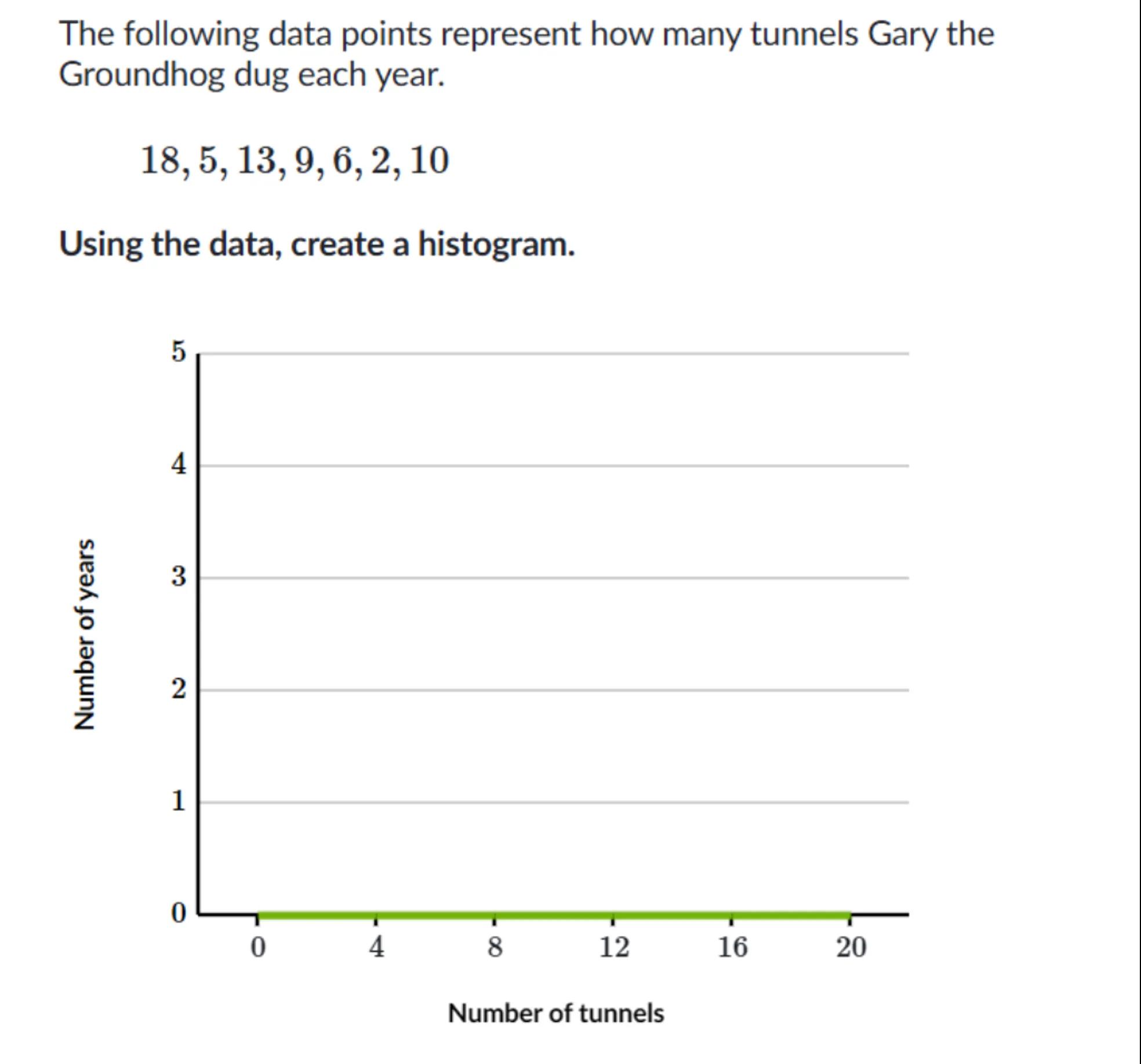
Sia

Question
Statistics
Posted 8 months ago
The following data points represent how many tunnels Gary the Groundhog dug each year.
Using the data, create a histogram.

Answer from Sia
Posted 8 months ago
Solution by Steps
step 1
First, we need to determine the range of the data points. The given data points are: . The minimum value is and the maximum value is
step 2
Next, we decide on the number of bins for the histogram. A common choice is to use the square root of the number of data points. Here, we have 7 data points, so . We can round this to 3 bins
step 3
Calculate the bin width. The range of the data is . Dividing this by the number of bins (3), we get a bin width of . We can round this to 5 for simplicity
step 4
Define the bin intervals. Starting from the minimum value (2), the bins will be:
- Bin 1: 2 to 7
- Bin 2: 7 to 12
- Bin 3: 12 to 17
- Bin 4: 17 to 22
step 5
Count the number of data points in each bin:
- Bin 1 (2 to 7): (3 data points)
- Bin 2 (7 to 12): (2 data points)
- Bin 3 (12 to 17): (1 data point)
- Bin 4 (17 to 22): (1 data point)
step 6
Draw the histogram with the bins on the x-axis and the frequency (number of data points) on the y-axis
Answer
The histogram will have 4 bins with the following frequencies: Bin 1: 3, Bin 2: 2, Bin 3: 1, Bin 4: 1
Determining the Smallest Sample Size for a Desired Margin of Error
step 1
To determine the smallest sample size for a desired margin of error , we use the formula:
where is the Z-score corresponding to the desired confidence level, is the population standard deviation, and is the margin of error
step 2
Identify the values for , , and . For example, if we want a 95% confidence level, . Suppose and
step 3
Substitute the values into the formula:
Since the sample size must be a whole number, we round up to 97
Answer
The smallest sample size required is 97
Calculating the Mode of a Set of Numbers
step 1
The mode is the number that appears most frequently in a data set. Given the data points: , we count the frequency of each number
step 2
Since all numbers appear only once, there is no mode in this data set
Answer
There is no mode in the given data set
Finding the Mean and Standard Deviation of the Distribution
step 1
To find the mean, sum all the data points and divide by the number of data points:
step 2
To find the standard deviation, first calculate the variance. The variance is the average of the squared differences from the mean:
step 3
The standard deviation is the square root of the variance:
Answer
The mean is 9 and the standard deviation is approximately 4.96
Key Concepts and Explanations
Key Concept
Histogram creation involves determining bin intervals and counting data points within those intervals
Explanation
A histogram visually represents the frequency distribution of a data set by grouping data points into bins
Key Concept
Sample size determination uses the margin of error formula involving Z-score and standard deviation
Explanation
The formula helps in calculating the minimum sample size needed to achieve a desired margin of error at a specific confidence level
Key Concept
The mode is the most frequently occurring number in a data set
Explanation
If no number repeats, the data set has no mode
Key Concept
Mean and standard deviation are measures of central tendency and dispersion
Explanation
The mean is the average of the data points, while the standard deviation measures the spread of the data points around the mean
Not the question you are looking for? Ask here!
Enter question by text
Enter question by image
Unlock Smarter Learning with AskSia Super!
Join Super, our all-in-one AI solution that can greatly improve your learning efficiency.
30% higher accuracy than GPT-4o
Entire learning journey support
The most student-friendly features
Study Other Question